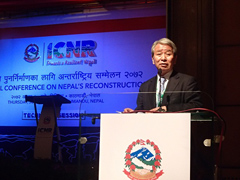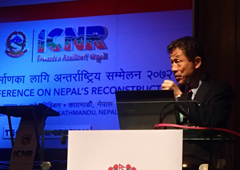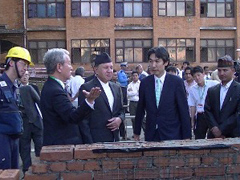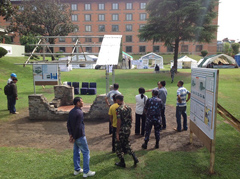JICA Officials Emphasize 'Build Back Better,' 'Seamless Transition' at Donors' Conference in Nepal
On June 25, two months after a large earthquake in Nepal, representatives of donor countries, including JICA President Akihiko Tanaka, attended the International Conference for Nepal's Reconstruction in Kathmandu.
At a technical session entitled "Towards a Resilient Nepal," Tanaka gave a presentation on the theme of reconstruction based on “Build Back Better,”*1 and JICA Senior Advisor Kimio Takeya gave one on urban reconstruction.
The donors' conference consisted of an opening session (speeches by Cabinet members and others from Nepal and various other countries), a business session (announcements of assistance needs and pledges of support from countries and aid agencies) and a technical session. The technical session, during which JICA representatives spoke, was an opportunity to discuss specific and technical approaches for effectively using the assistance amount stated in the opening session and business session. At the session, there was discussion of the technical aspects of effective cooperation based on the "Build Back Better" concept for realizing reconstruction that overcomes Nepal's vulnerability to disasters.

JICA President Akihiko Tanaka comments on future assistance in the housing sector at a donors' conference.
Tanaka spoke about earthquake recovery cooperation to Nepal from JICA and the two concepts of "Build Back Better" and "a seamless transition from emergency relief immediately after a disaster to rehabilitation and reconstruction." He explained specific assistance measures in Nepal.
He started by saying that immediately after the earthquake on April 25, a team was dispatched to consider the general framework of reconstruction. To prepare for future risk in the Kathmandu capital area, measures that incorporate "Build Back Better" are needed in urban areas, in addition to recovery assistance to rural areas that suffered the greatest damage such as Sindhupalchok and Gorkha provinces, he said.
Next, regarding housing reconstruction, a sector that accounts for about 50 percent of the reconstruction need, he proposed a three-stage assistance method:
- 1 . Demonstration of the Shelter to Permanent (STP) construction method, nicknamed "Ganjo House." In this method permanent housing is constructed in the same location as temporary housing, using the latter's frame.
- 2 . Trial construction of seismic strengthened model housing.
- 3 . More extensive housing reconstruction assistance making use of expertise in and lessons learned from model house construction.
Tanaka also emphasized the need make the reconstruction effort “inclusive,” to allow all people to share the benefits of housing reconstruction, given the social and cultural background of the affected areas, where many households are headed by the elderly or women.
After that, Takeya explained initiatives to increase the resilience of the capital area in preparation for earthquakes that may occur, along with concrete plans.
He said that first, during reconstruction, the government must engage in "investment in disaster risk reduction" as a national policy to prepare for the "underlying disaster risk." Regarding the overall economic impacts of “underlying disaster risk” and “investment in disaster risk reduction,” he gave an introduction to the economic model “DR2AD*2” JICA is developing. In addition, he presented the results of an earthquake risk assessment of the Kathmandu capital area performed in 2002, and reported that JICA is updating the assessment based on subsequent changes such as population growth and advancing urbanization.

Takeya explained the need to rebuild housing to be “strong” or “resilient” during reconstruction in Nepal.
Takeya gave an example from reconstruction projects in the housing sector. He emphasized that rather than rebuilding vulnerable housing that will collapse in an earthquake of the same magnitude, the central government should take strong leadership in promoting “strong” housing that will not be destroyed by an earthquake, or at least “resilient” housing, which is comparatively easy to rebuild and protects human lives.
JICA has promoted the concept of "Build Back Better" to the Government of Nepal and the international community through the "Build Back Better Reconstruction Seminar for Nepal," which was jointly sponsored by the Government of Nepal on May 25, one month after the earthquake in Nepal.
Participants in this donors' conference came from 33 donor countries and many international organizations, and they pledged some $US4.4 billion in assistance to the Government of Nepal (according to documents it released). The fact that during this meeting, not only the Government of Nepal, but also the governments of various countries and international organizations repeatedly commented on the importance of "Build Back Better" shows that the philosophy of the “Sendai Framework for Disaster Risk Reduction (2015-2030),” an international guiding agreement on disaster risk reduction, continues to disseminate widely. It is expected that the philosophy agreed in Sendai will be applied to the activities in Nepal’s reconstruction.
For urgent housing assistance needs
The rainy season in Nepal started in late June. So assistance with housing, which keeps out wind and rain, is an urgent matter for victims who lost their homes in the earthquake. Roughly half of the reconstruction needs announced by the Government of Nepal are for the rebuilding of housing, the sector with the most urgent need.
Taking advantage of the opportunity afforded by this gathering of high-ranking officials of the Nepalese Government and representatives of various governments and international organizations, JICA put up displays of housing and building reconstruction on June 24-25. They showcased the STP construction method, which allows people living in temporary housing to seamlessly transition to permanent housing, and a method for constructing seismic strengthened model housing. The displays were based on the concept of “Build Back Better,” in which earthquake resilience is improved over what existed before an earthquake.
Rural housing based on the STP method can be built by residents using the frame of a tent shelter put up as temporary housing and local materials such as rocks. Also, using this construction method has the advantage that residents need not move from temporary housing to permanent housing. What's more, materials supplied through public assistance when temporary housing was built can be reused to create more anti-seismic housing. At the donors' conference, JICA gave a concrete presentation of the STP construction method as a minimum standard that should be followed when providing housing assistance.

A visit to a model house construction display in Tribhuvan University. From left are Senior Researcher Tomohisa Mukai, Building Research Institute, National Research and Development Agency, Japan; JICA President Akihiko Tanaka; Minister for Urban Development of Nepal Narayan Khadka; State Minister for Foreign Affairs of Japan Minoru Kiuchi; and Hiroshi Kaneko, director of the Urban Planning Department of the National Institute for Land and Infrastructure Management, Ministry of Land, Infrastructure, Transport and Tourism.
In addition to the STP method, Minister for Urban Development Narayan Khadka and other Nepalese government officials, as well as State Minister for Foreign Affairs Minoru Kiuchi, who was visiting Nepal to attend the conference as a representative of the Japanese Government, also visited other construction method displays. At the Tribhuvan University venue, there was a demo construction of a mesh-reinforced brick wall and a display of brick housing for urban areas with an added framework of reinforced concretes pillars. The two venues received some 830 visitors including local scholars, students and NGO personnel, showing a high level of interest.

A seismic strengthened model house display put up at the hotel where the donors' conference was held.
JICA will continue supporting the Government of Nepal to promote concrete efforts to disseminate and expand the construction methods exhibited in the demo sites. JICA will also take a leadership role in incorporating international strategies for Disaster Risk Reduction such as the “Sendai Frame for Disaster Risk Reduction (2015-2030)” in actual projects in Nepal and beyond.
*1 "Build Back Better" is a concept that arose from the lessons learned by developing countries in particular when they rebuilt from one disaster only to be struck by disaster again repeatedly. It also is a priority for action under the “Sendai Framework for Disaster Risk Reduction (2015-2030)” adopted at the Third UN World Conference on Disaster Risk Reduction held in Sendai in March.
*2 DR2AD is a simulation model for evaluating the effects on post-disaster GDP depending on whether a country made investments in disaster risk reduction in advance. Using this economic assessment model, JICA shows high-ranking government officials of developing countries and the international community the effectiveness and importance of investments in disaster risk reduction.




scroll